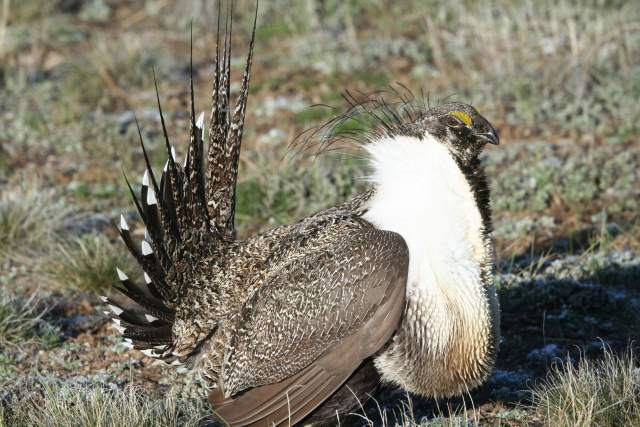June 2, 2015

In a speech straight from the hymnal of “I’m from the government and I’m here to help,” Secretary of the Interior Sally Jewell last Thursday announced the most ambitious and aggressive conservation effort ever undertaken on public land.
The effort, from the government’s perspective at least, is designed to conserve habitat for the greater sage grouse in 10 Western states, with the intent of keeping the bird from being listed under the Endangered Species Act.
That’s an outcome everyone can get behind. The rub comes in how the federal government wants to get that done.
According to Jewell, the Bureau of Land Management (BLM) and the U.S. Forest Service (USFS) released final environmental reviews for proposed land use plans that “will help conserve greater sage grouse habitat and support sustainable economic development on portions of public lands in 10 states across the West.” That’s according to the news release from the Department of Interior (DOI) announcing the effort. The release goes on to say that the effort “will benefit wildlife, outdoor recreation, ranching and other traditional land uses that rely on a healthy sagebrush landscape.”
In short, the BLM released plans to amend nearly 100 resource management plans across the West, along with 14 Environmental Impact Statements. The plans will undergo a 60-day Governor’s Consistency Review period and concurrent 30-day protest period, after which Records of Decision will be signed, according to the DOI release.
Don’t misunderstand. BEEF and the vast majority of ranchers in the West strongly support wildlife conservation efforts, particularly if those efforts have strong state involvement and work to truly embrace all aspects of modern land management. The sage grouse effort fails on many of those fronts.
Hiding behind all the warm, fuzzy rhetoric about how the BLM and Forest Service will circle up and hold hands with ranchers, energy companies and other consumptive users on federal lands is what some refer to as the Obama exit wave. In short, they’re from the government and they have no intention of helping you.
The Nevada Cattlemen’s Association (NCA) is beginning to review the final plans and make comments, says Ron Torell, NCA president. “NCA along with the Public Lands Council remain concerned that these plans contain unworkable requirements dealing with buffer zones and stubble height while also discussing livestock grazing reductions and removal. These plans show the administration’s unwillingness to defer to state management plans,” Torell says.
Among the many sticking points that cattle producers find in the sage grouse conservation plans released last week, that’s one that is most irritating—the fact that the federal government has initiated a one-size-fits-all plan that seems to disregard state efforts to develop conservation plans tailored to local needs.
In fact, the National Cattlemen’s Beef Association pulled no punches it its analysis. “Upon initial review of the resource management plans, the livestock industry is concerned the BLM and USFS have overstepped. Inclusion of one-size-fits-all requirements on how multiple uses, including livestock grazing, will be managed on public lands is not the answer to conserving sage grouse,” NCBA says.
So how did the agencies overstep? NCBA says the agencies included legally questionable provisions in the resource management plans which run contrary to what the U.S. Fish and Wildlife Service has requested for protecting the bird.
Here’s where NCBA spoke in plain language. “These plans are yet another example of the administration targeting rural America in an attempt to appease radical preservationists in removing productive uses from the land. The administration needs to realize that ranchers with public land grazing rights work daily to minimize the major threats to sage grouse: removing fine fuels and providing vast tracts of open space. Wildfire and development are the primary threats to the sage grouse and its habitat, yet this administration is systematically wiping out multiple-use and ranching through regulatory overreach.”
Ultimately, this effort will end up in federal court, where a judge will decide the future of public land use on the estimated 50 million acres of federally-managed sage grouse habitat. For perspective, that’s about the size of South Dakota.
And that doesn’t count the millions of acres of privately-owned land that will also fall under the sage grouse conservation plans, should they be adopted.
Fighting the federal government in court is unfortunate, because that is money, time and effort that could be put to much better use—like conserving sage grouse habitat in a truly cooperative and positive environment, rather than a command and control, top-down effort run from Washington D.C. that does nothing but further the already strong distrust that many Americans have in their government.
What’s also unfortunate is this isn’t the last of it. Be prepared for more pronouncements from the federal government in the coming year couched in warm, fuzzy rhetoric that hides a deeper intent. Just as with Waters of the U.S. (WOTUS) and the sage grouse plan, we must read carefully what the proposed regulations really say and really mean.
Indeed, the Obama exit wave continues. Now more than ever, your membership and involvement is needed in your state and national livestock organizations.
You might also like:
How to prevent & treat pinkeye in cattle
7 tools to win the war against cattle flies
Picture perfect summer grazing scenes from readers
You May Also Like



